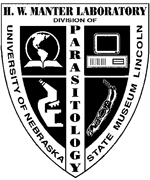Parasitology, Harold W. Manter Laboratory of

Harold W. Manter Laboratory of Parasitology: Library Materials
ORCID IDs
Escalante 0000-0002-1532-3430
Document Type
Article
Date of this Version
10-12-2011
Citation
BMC Evolutionary Biology (2011) 11: 299
doi: 10.1186/1471-2148-11-299
Abstract
Background: Timing the origin of human malarias has been a focus of great interest. Previous studies on the mitochondrial genome concluded that Plasmodium in primates, including those parasitic to humans, radiated relatively recently during a process where host switches were common. Those investigations, however, assumed constant rate of evolution and tightly bound (fixed) calibration points based on host fossils or host distribution. We investigate the effect of such assumptions using different molecular dating methods. We include parasites from Lemuroidea since their distribution provides an external validation to time estimates allowing us to disregard scenarios that cannot explain their introduction in Madagascar.
Results: We reject the assumption that the Plasmodium mitochondrial genome, as a unit or each gene separately, evolves at a constant rate. Our analyses show that Lemuroidea parasites are a monophyletic group that shares a common ancestor with all Catarrhini malarias except those related to P. falciparum. However, we found no evidence that this group of parasites branched with their hosts early in the evolution of primates. We applied relaxed clock methods and different calibrations points to explore the origin of primate malarias including those found in African apes. We showed that previous studies likely underestimated the origin of malarial parasites in primates.
Conclusions: The use of fossils from the host as absolute calibration and the assumption of a strict clock likely underestimate time when performing molecular dating analyses on malarial parasites. Indeed, by exploring different calibration points, we found that the time for the radiation of primate parasites may have taken place in the Eocene, a time consistent with the radiation of African anthropoids. The radiation of the four human parasite lineages was part of such events. The time frame estimated in this investigation, together with our phylogenetic analyses, made plausible a scenario where gorillas and humans acquired malaria from a Pan lineage.


Comments
Open access
License: CC BY 2.0